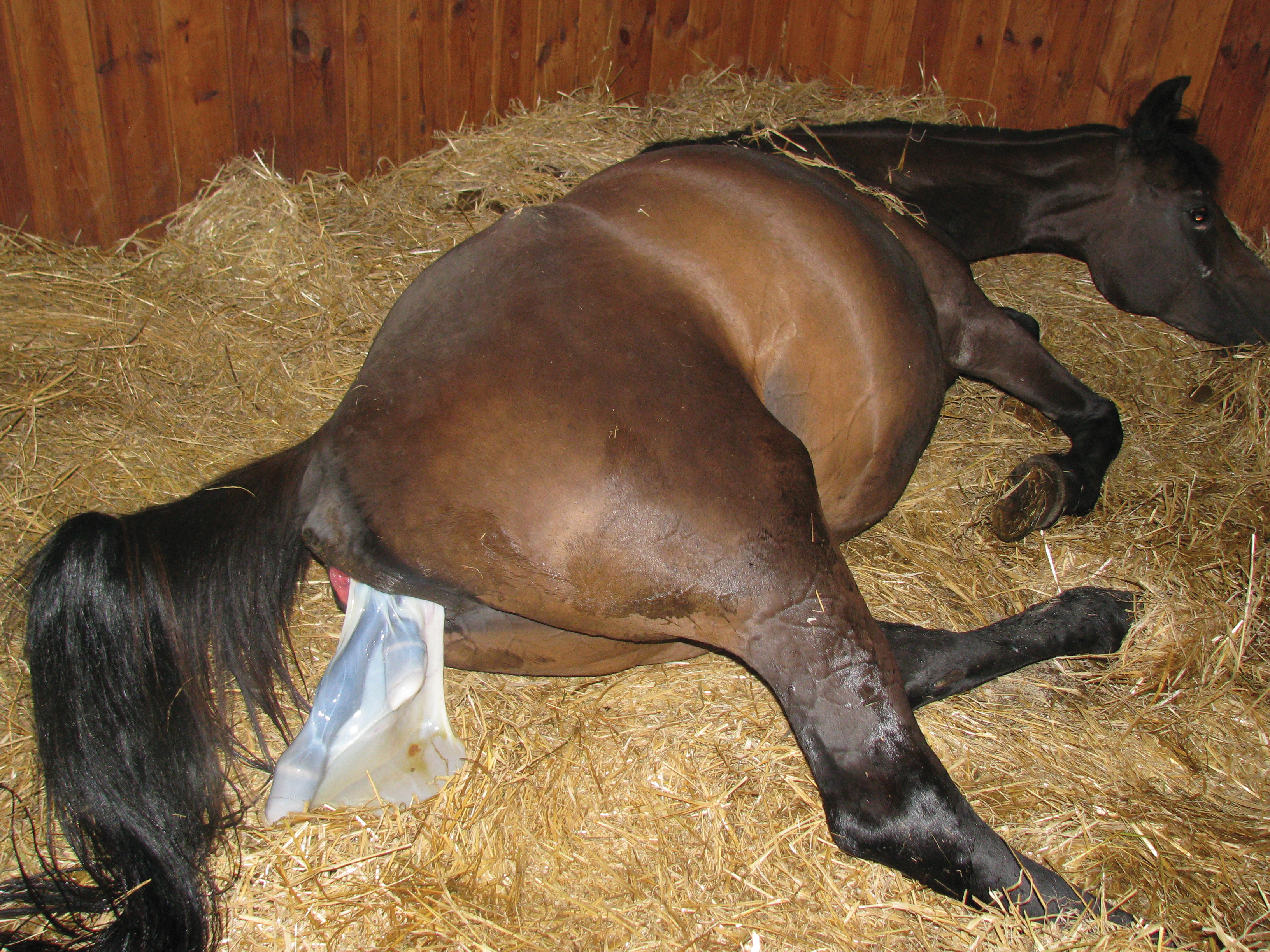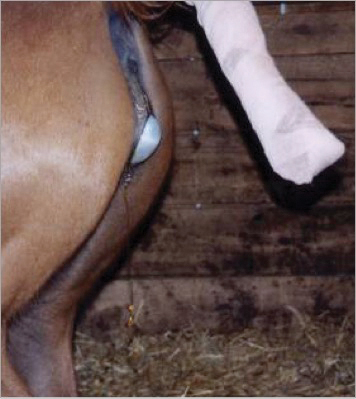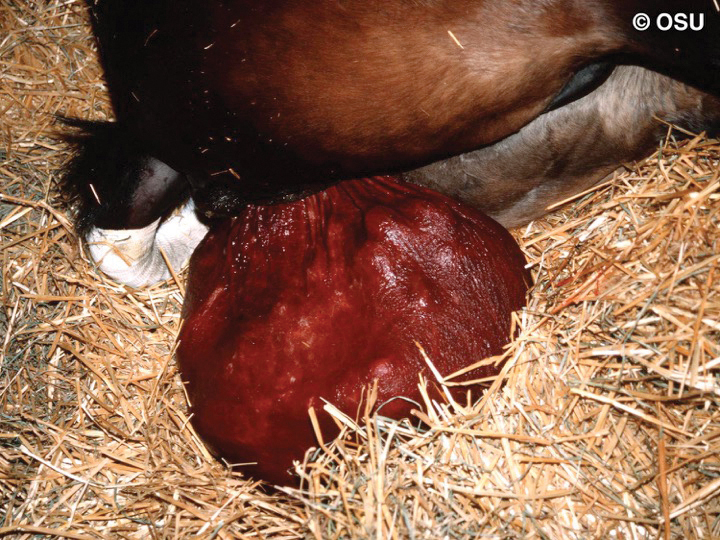
Placentia Previa or ‘Red Bag’ Foaling
 Most equine births are accomplished with no problems. The mare goes into active labor, breaks her water, lies down and almost immediately, the foal’s front feet appear, followed by his nose and head. With a few forceful contractions, the mare delivers the foal and the second stage of labor is complete. Occasionally, however, there are problems that hinder the progression, resulting in a life-threatening emergency.
Most equine births are accomplished with no problems. The mare goes into active labor, breaks her water, lies down and almost immediately, the foal’s front feet appear, followed by his nose and head. With a few forceful contractions, the mare delivers the foal and the second stage of labor is complete. Occasionally, however, there are problems that hinder the progression, resulting in a life-threatening emergency.
One example, though rare, is placenta previa, which is when part of the placenta comes ahead of the foal. The placenta is detaching too soon, and coming through the birth canal with the foal still within the non-ruptured placenta and chorioallontis containing the allantoic fluid, instead of following the foal. This situation is often called a “red bag” delivery, because what you see first is the red, velvety-looking placenta instead of the whitish-clear amnion sac encasing the foal. The placenta is covering the foal’s head and has not ruptured to allow the foal to come through.
 Eric Schroeder DVM, MS, DACVECC, DACVIM, Assistant Professor-Equine Clinical Track, Department of Veterinary Clinical Sciences at Ohio State University, says there can be several reasons why this happens. “Fescue toxicity, which is caused by the mare consuming endophyte-infected fescue pasture or hay during the last trimester of pregnancy, can be one cause, though many mares can be on fescue and never experience this problem,” he says.
Eric Schroeder DVM, MS, DACVECC, DACVIM, Assistant Professor-Equine Clinical Track, Department of Veterinary Clinical Sciences at Ohio State University, says there can be several reasons why this happens. “Fescue toxicity, which is caused by the mare consuming endophyte-infected fescue pasture or hay during the last trimester of pregnancy, can be one cause, though many mares can be on fescue and never experience this problem,” he says.
“One of the more important causes can be bacterial or viral infections affecting the placenta, which is called placentitis, but often we simply don’t know the cause and we may not ever figure it out. Something has triggered all of the placenta to release at once too quickly. One cause could be extended labor with a dystocia for a couple hours and the foal is dead. In this situation, the placenta detached naturally and is simply coming ahead of the foal,” Schoeder explains. “Detachment is a normal bodily process during labor, but generally happens after the birth. If there is a systemic problem with the foal or the foaling procedure, the placenta may detatch before the foal is delivered.
This premature placental separation, often called a “red bag delivery” is not common. “It only accounts for approximately 5 to 10% of all causes of abortion, stillbirth or perinatal death. When this condition does occur, it is an extreme emergency because the placenta is the foal’s life support while in utero. It provides oxygen and nutrients and if it detaches before he is fully born, the foal runs out of oxygen.”
The mare’s oxygen supply is the foal’s oxygen supply. “The foal is always in a relatively oxygen-poor environment while he is in the uterus. Once stage two labor starts, the foal is in a low oxygen state and the clock is ticking. We generally say that the foal must be born and on the ground within 30 minutes or less with an average of 5 to 20 minutes from the time the mare starts active labor.”
Many mare watchers have said they took time out to have a cup of coffee and when they got back the foal was already on the ground and trying to get up.
“Vigilance is paramount when watching mares, to be there if she does need help. If you see a mare in stage two labor that has protrusion of the placenta rather than the clear, white amnion, this is an absolute emergency, to open it. The foal should be right on the other side of the amnion sac inside that placental covering. It should be front feet and nose, but might be hind feet, or some other part of the foal,” says Schroeder.
“You can’t tear the placenta with your hands because it is too strong, thick and rubbery. You need something sharp to cut it, like scissors,” he says. If the mare has a placentitis, this tissue may be very tough and nearly impossible to puncture with your fingers. It’s best to have a pair of scissors in your foaling kit to poke through the placenta.
“We generally don’t recommend knives because people tend to go too deeply and cut more than the placenta, especially if they are in a panic to resolve the problem. Once you get it open, however, it can be torn away from the feet or nose and everything after that usually goes well. The mare can do the rest and push the foal out normally,” he explains.
 There will be a poor outcome if no one notices the red bag delivery. The birth may be slower, and the foal cannot break through the thick placenta causing it to suffocate. “There is minimal to no chance for that foal to live. If someone is there, however, the placenta can be cut open. That person will generally go ahead and provide some controlled assistance to bring the foal out quickly, or at least pull the bag across and off the foal’s head and most importantly, off the nose so it is behind the ears and there is no obstruction as the mare pushes the foal on out.
There will be a poor outcome if no one notices the red bag delivery. The birth may be slower, and the foal cannot break through the thick placenta causing it to suffocate. “There is minimal to no chance for that foal to live. If someone is there, however, the placenta can be cut open. That person will generally go ahead and provide some controlled assistance to bring the foal out quickly, or at least pull the bag across and off the foal’s head and most importantly, off the nose so it is behind the ears and there is no obstruction as the mare pushes the foal on out.
“If the placenta is coming out all at once with the foal, obviously stage three labor is accomplished at the same time. We typically do not have to worry about retained fetal membranes. Stage two and three are happening simultaneously and all is well, but I still like to try to figure out the reason why the mare had a red bag delivery. Is it just by happenstance, or was there something in her recent medical history that triggered this? Has the mare been sick with diarrhea, colic or some other problem? Was she a problem mare to get bred? Does she have a history of bacterial or viral placentitis? Was she exposed to a toxin like Eastern Tent caterpillars or did she have any infectious reproductive diseases such as herpes virus or a fungal endometritis? It’s a good idea to do some investigative work to figure it out.”
Ideally, the placenta would be submitted to a diagnostic lab to have it checked for any evidence of disease. “It’s a good idea to have someone look at it for further testing. The last thing we’d want to see on any farm is a brewing underlying problem that no one knew about until this mare’s red bag delivery. This could be one of the first signs of a major abortion-causing problem that might affect other mares, which could be very devastating to a farm,” says Schroeder.
In terms of the foal, if someone was there to cut through the placenta in time and the foal was born quickly, he would probably be fine, but it is always prudent to have the new foal examined by a veterinarian. In some instances, however, he may have been without oxygen too long, which might result in “dummy foal” syndrome or perinatal asphyxia syndrome. “He may have been compromised more than the average foal that was born normally. If people don’t want to bring the foal in for checking, they need to be vigilant in monitoring that foal. Is he nursing regularly and getting up and down normally? Is he going through the normal cycle of getting up, nursing, napping, playing, etc., multiple times per hour? These foals usually act normally for the first 24 hours. After that, they may decline if they are becoming a bit slow,” he explains.
“I tell people to diligently monitor that foal for the first 72 hours. This isn’t a mare and foal you would just turn out to pasture. You’d want them in an area where they can be readily observed and then you’d know if the foal becomes dull and is lying around more. You’d notice that the foal, who was up nursing vigorously at first, is now just lying around and more lethargic,” he says.
“Here at our referral hospital, we are usually dealing with the after effects. Either the foal didn’t survive because they missed it and want to know what to do in the future to try to prevent this happening again, or I may be dealing with a foal that’s slow, that was born with a red bag delivery. People might bring the foal here for us to monitor to make sure everything is normal and going correctly, or the foal is already showing some of the classic clinical signs of dummy foal syndrome,” says Schroeder.
Vigilance is Crucial
“We may not know what caused the problem, whether it was exposure, lack of appropriate vaccinations, or previous history, but we try to educate people about what to do if they see a red bag delivery. It’s not a sit and wait situation. If you see this dark red bag starting to show at the vulva, it’s time to act, now,” Schroeder explains. “Not much of it has to be out for you to be able to make a small cut in it because after you get that cut started, you can tear it.
“Once you do that, Mother Nature can pretty much take over, but if I was the person opening up that placenta, I would probably go ahead and actively help pull that foal on out, rather than just stand there and wait.” he says.
A red bag delivery is a huge problem when it happens, but fortunately it doesn’t happen very often. “It usually results in a dead foal unless someone is right there to deal with it. All too often, people find the newborn foal dead, still encased in that red bag because he was unable to get through. In a red bag situation, the foal is at an extreme disadvantage.”
On big breeding farms, there are generally people watching mares around the clock in the foaling barns. “The typical schedule is to check the mares every 15 minutes or even more frequently, and some barns have cameras/videos, or foaling alert systems to signal the beginning of stage two labor. If it’s a valuable mare or a high-risk case, they may pay someone to sit there and watch that mare, or take shifts,” says Schroeder.
“They try to give every mare every possibility of a positive outcome. A red bag emergency may not be as frequent as some of the other major problems, but can be a serious issue,” he says. A red bag foaling is a very random event, but the more mares a person is foaling out, the more likelihood that it might, at some time, be encountered.
“Once you see it, you never forget it. This is a traumatic emergency, and the farm personnel are the only ones who will be able to save the foal. They are probably the only people who would be able to do something in time, unless the veterinarian is already there on the farm, and hopefully in that foaling barn. On a big horse farm, the vet may be clear over on the other side of the farm, so the farm employees may still be the ones that have to try to save the foal,” he says.
There is usually a foaling kit in each barn, containing things that might be needed for many kinds of emergencies and the scissors could be useful for a red bag emergency. If you are in the stall with the mare when it happens and there isn’t time to run to the foaling kit a person could carefully use a pocketknife or anything sharp to get a hole through the placenta to get fingers into and to pull it apart.
“All my technicians here at the hospital are trained to act fast. If they see this happen, they need to open up that red bag and call us afterward. Anyone watching a mare should be prepared for this possibility. It happens quickly, and if a person has to think about it or call a veterinarian, it is usually too late,” he says.
Post-Foaling
 After a red bag delivery, you don’t have to do much for the mare. “She has already shed the placenta and cleaned out. There should be no reason that she can’t carry more foals, unless there is something vastly wrong with the placenta and its attachments,” says Schroeder.
After a red bag delivery, you don’t have to do much for the mare. “She has already shed the placenta and cleaned out. There should be no reason that she can’t carry more foals, unless there is something vastly wrong with the placenta and its attachments,” says Schroeder.
Thus, it pays to check that placenta. “This is something many owners forget about and I stress the importance of allowing the placenta to be tested and/or have a histopathology run, looking at it under a microscope. If there are large areas that are grossly abnormal, this is almost always a clue about the health of the uterus. If there are large scarred areas, maybe the uterus is not as healthy as it should be for carrying a foal. The placenta can provide a lot of information,” he says.
Since it should be checked quickly before it starts to deteriorate, it is important to get the placenta to a pathologist as soon as possible. “You can’t leave it lying out in the hot sun for several hours, drying out. Collect it and keep it clean in a plastic trash bag to send immediately. If the mare foaled at night, you can put it in the refrigerator until it can be sent the next morning,” says Schroeder.
“In areas of the country where there are many breeding farms, the labs are prepared to deal with these things during foaling season and are open seven days a week. Most veterinarians who are doing reproductive work or new foal exams would be in tune with what to do and where to send it and what to ask for. In Kentucky and Ohio, for example the state diagnostic lab is well keyed-in regarding what to look for. There are people who specialize in this, but any pathologist should be able to handle it.”
